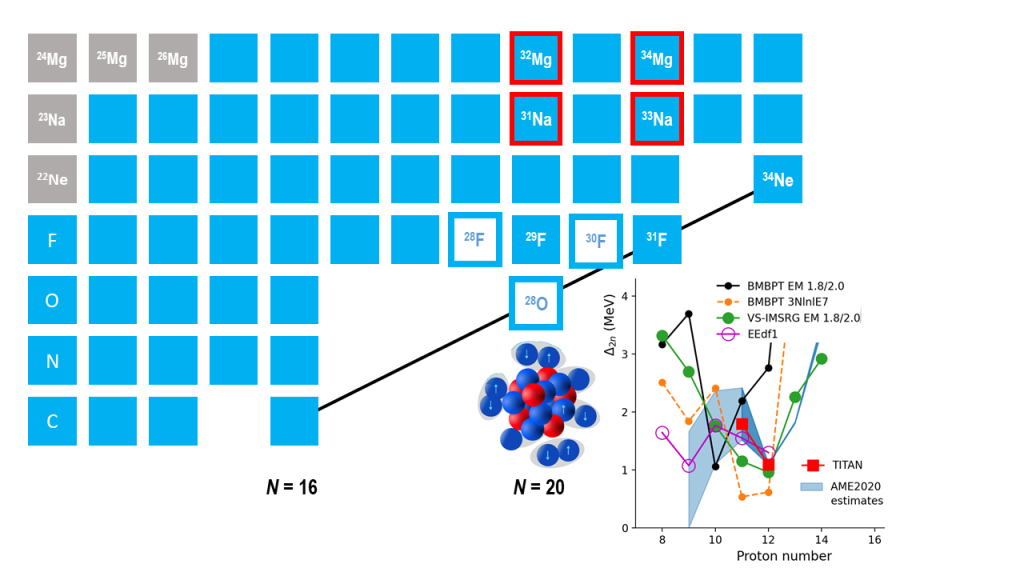How low can it go?!
50 years after the pioneering experiment at CERN, TRIUMF and Orsay – with a “little help from their friends” at GSI and Uni-Giessen – weigh exotic isotopes of sodium
Precision mass spectrometry has played a central role in nuclear physics from the beginning of the field a century ago. The installation of mass spectrometers at accelerator facilities opened a new era in the discovery of new nuclear-structure phenomena, pioneered by the Orsay group of Thibault, Klapisch et al., with the on-line mass measurements the sodium isotopes out to N=20 in 1975.
On the 50th anniversary of this milestone, the same Orsay group has collaborated with scientists from TRIUMF (as well as GSI and University of Giessen), measuring the masses of these key isotopes with the TITAN mass spectrometer at TRIUMF’s ISAC facility, achieving up to two orders of magnitude more accuracy (Lykiardopoulou et al. PRL, 2025). This and other collaborations with TRIUMF (using e.g. the GRIFFIN, TUDA and DRAGON setups) has triggered the recent creation of the International Research Laboratory (IRL) concentrating on nuclear physics, nuclear astrophysics and accelerator technologies (npat.in2p3.fr)
As with the quantum atomic orbitals that organize the columns of the period table, the atomic nucleus also features favored quantum configurations that make nuclides with certain so-called “magic” numbers of protons or neutrons, more tightly bound.
But near the limits of nuclear stability, even doubly magic configurations are insufficient for the strong force to hold on to any extra nucleons. Such is the case for oxygen-28, recently found to be unbound through experiments with the SAMURAI spectrometer at RIKEN, despite its closed proton (Z=8) and neutron (N=20) shells. [Kondo et al. Nature, 2023]
Published in Physical Review fifty years later, the new results of Lykiardopoulou et al. show that the wilting N=20 shell reaches a minimum for magnesium-32 (Z=12) but then increases again for sodium-31 (Z=11). The gain is small (700 keV) but significant compared to the modest shell energy of 1100 keV.
This increase raises the tantalizing question of whether the N=20 shell might continue to recover, even when venturing from the shore of weakened nuclear stability into the shallow waters of the unbound closed shell oxygen (Z=8) isotopes.
The figure below illustrates the nuclear landscape being characterized.

Nuclides at the limits of stability are produced by radioactive beam facilities, of which several exist worldwide, forming two families: in-flight/fragmentation and ISOL that play the respective roles of “discovery” and “precision” machines, as in high-energy physics. RIKEN uses fragmentation of a heavy ion beam accelerated to GeV energies on a very thin target. TRIUMF’s ISAC facility uses the so-called ISOL (isotope separation on-line) where high-energy driver beams (usually protons) hit a thick target and the exotic isotopes diffuse from the heated target matrix. ISOL beams tend to be less exotic but are produced at very low energy and of better optical quality that makes them amenable to precision measurements. It is the fragmentation facilities that slice into the terra incognita, producing the first glimpses of new isotopes.
The mass plays an essential role for determining the limit of existence nuclear systems that can be bound by the strong force – the drip line (beyond which neutrons “drip” out of the heaviest bound system. As seen in the figure, oxygen exhibits a particularly anomalous behavior which has spurred the development of a new class of “ab initio” nuclear model – developed “from the beginning”.
The collaboration compared their results to state-of-the-art ab initio approaches using interactions derived from chiral effective field theory, including a newly improved three-nucleon component, rooted in the description of the strong force from quantum chromo-dynamics (QCD).
These various approaches (elaborated by theorists from TRIUMF, Japan and the CEA in France) were compared in the paper and while the absolute values agree very well with the experimental results for Z=12 and 11, the extrapolations down to Z=8 range from 1.8 MeV to 3.3 MeV – with all of them larger than the minimum value of 1.1 MeV measured for Z=12. Moreover, most results predict a larger shell gap for oxygen (Z=8) compared to fluorine (Z=9).
Of particular mention are the EEdf calculations from University of Tokyo and Tsukuba, which were performed for both the RIKEN and TRIUMF experiments. The EEdf results correctly account for the bound fluorine-31 isotope (also established experimentally by the RIKEN/SAMURAI collaboration and reported by Ahn et al. PRL 2019).
More recent work by the SAMURAI-NEULAND presented masses of the unbound fluorine-28 and 30 [Kahlbow et al. PRL 2024] that hint at the possible existence of a “neutron ballet” in oxygen-28, which refers to a putative new phase of nuclear superfluidity in which the neutron orbits move much closer together, even to the point of entanglement. (https://www.in2p3.cnrs.fr/fr/cnrsinfo/le-surprenant-ballet-de-neutrons-de-loxygene-28)
Kahlbow et al. used the neutron separation energy to evaluate the shell strength, while Lykiardopoulou et al. use the complementary two-neutron separation energy. The advantage of the latter is that it removes the pairing contribution from the separation energy to home in on the shell strength. The disadvantage is that an extra mass – one neutron farther away – is required.
As often happens in research, answering old questions raises new ones. The idea of nuclear superfluidity is indeed a new fascinating question – one that we are on the brink of investigated using these advanced complementary experimental and theoretical approaches.
The advances in instrumentation sensitivity and accuracy are impressive. But the fact that in fifty years, such measurements could only reach one or two neutrons further from stability highlights the importance of the new-generation machines now under construction: ARIEL at TRIUMF and SPIRAL2 in France.
This publication marks the beginning of a new Franco-Canadian International Research Laboratory (IRL) created by the CNRS at TRIUMF, called NPAT: Nuclear Physics, Astrophysics and Accelerator Technologies
A similar IRL was created at the FRIB facility at Michigan State University last year. called NPA